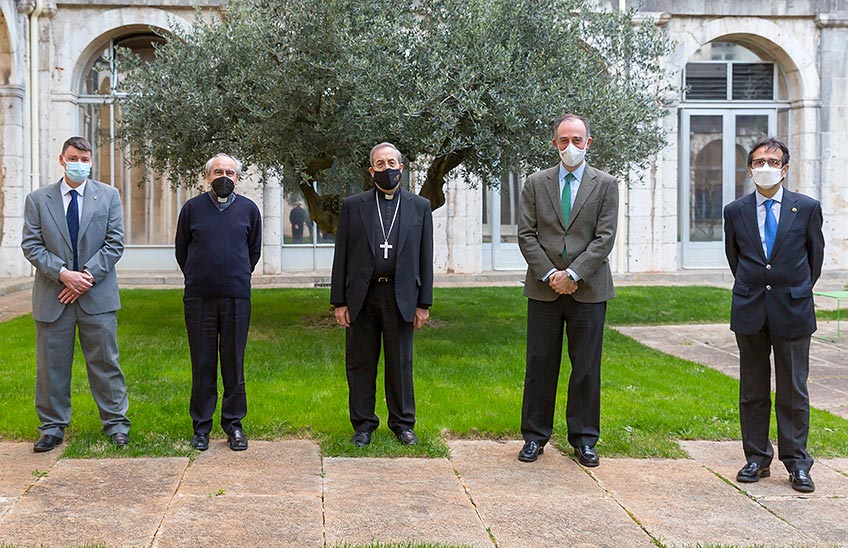Half a hundred people attended an online roundtable about St. Joseph, on the eve of his feast day.
The speakers discussed the presence of the saint in the spirituality, literature and arts of Navarre.

FotoManuelCastells/From left to right, Carlos Mata, researcher of GRISO; Don Santiago Cañardo, Vicar of Faith and Culture of the Archbishopric of Pamplona; Don Francisco Pérez, Archbishop of Pamplona; Tomás Gómez-Acebo, Vice President of Alumni of the University of Navarra; and Ricardo Fernández Gracia, director of the Chair de Patrimonio y Arte Navarro.
22 | 03 | 2021
Coinciding with the Year of St. Joseph, convoked by Pope Francis last December, and on the eve of its feast day, the Chair of Navarrese Heritage and Art of the School of Philosophy and Letters of the University of Navarra celebrated last March 18, in partnership with the Vicariate of Faith and Culture of the Archbishopric of Pamplona, the online roundtable "St. Joseph in the spirituality, letters and arts of Navarre". The event, presided over by Tomás Gómez Acebo, Vice President of Alumni of the University of Navarra, was attended by Msgr. Francisco Pérez, Archbishop of Pamplona; Carlos Mata, researcher of the group of research Siglo de Oro (GRISO); and Ricardo Fernández Gracia, director of the Chair de Patrimonio y Arte Navarro. The meeting was presented by Don Santiago Cañardo, Vicar of Faith and Culture of the Archbishopric of Pamplona.
The roundtable began with the presentation of the Apostolic Letter Patris Corde of Pope Francis, pronounced on the occasion of the 150th anniversary of the declaration of St. Joseph as Patron of the Universal Church, to position of Don Francisco Perez. In his speech, the Archbishop pointed out that the image of St. Joseph, present in numerous parishes of the Diocese, as well as in hermitages, confraternities, choirs or cooperatives of Navarre, or the auroras, novenas and devotionals composed in his name, "testify to the deep love of the people of Navarre for the spouse of Mary, who behind Joseph has seen a simple, hidden, humble man, who always goes unnoticed.""This is the center of all his spirituality and precisely therein lies his attraction: his hidden holiness is what makes him close to the hidden life of so many men and women of all times," he added.
For his part, Carlos Mata showed the presence of St. Joseph in Navarre's literature, from the devotional works and sermons of the Carmelites Raimundo de Lumbier or Jacinto de Aranaz, to the contemporary Christmas-themed poetry of writers such as Genaro Javier Vallejos, Luis Gil Gómez or José María Pérez Salazar, through popular literature and 18th century poetry, "where the verses become a prayer as simple and devout as it is emotional".
Professor Ricardo Fernández Gracia then discussed the presence of St. Joseph in Navarrese art, from his representation in capitals, doorways and medieval cloisters, "as a sleepy old man", to the Modern period, "where he began to be represented as a vigorous saint, both morally and formally, young and protector of the Holy Family". Supported by numerous examples of the Renaissance, such as the altarpiece of the Cathedral of Pamplona, and of the Baroque, such as the main altarpiece of Subiza or the convent of the Augustinian Recollect Nuns of Pamplona, Professor Fernández Gracia explained that the promoters of this transformation in the conception of the image of St. Joseph were, with their works, in which they vindicated his figure, "Jean Gerson, Chancellor of the University of Paris; the Dominican Isidoro Isolano; Saint Teresa of Jesus; and Father Jerónimo Gracián". Likewise, the declaration of March 19 as a feast of obligation and his declaration as patron of the Church in 1870 "had its translation in the arts, which originated an impulse of his iconography and the creation of numerous works in many parishes of Navarre and especially in the Carmelite convents".




